電気光学(EO)変調器
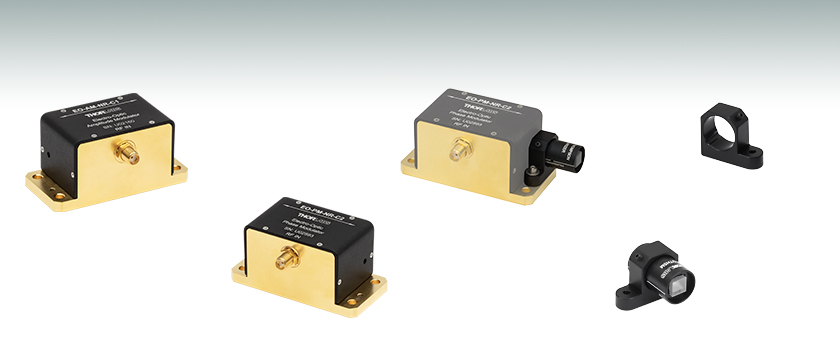
- High Performance Lithium Niobate Amplitude & Phase Modulators
- SMA RF Modulation Input Connector
- Broadband DC Coupled or High-Q Resonant
EO-AM-NR-C1
EO-PM-NR-C2
EO-GTH5M Application
EO-PMT
EO-GTH5M

Please Wait
ニオブ酸リチウム電気光学(EO)変調器
自由空間型ニオブ酸リチウム電気光学(EO)変調器は、当社の結晶光学と高速電子回路技術を組み合わせています。当社の電気光学(EO)変調器は、ハイパワーおよび短波長で動作できるよう、ニオブ酸リチウムに酸化マグネシウム(MgO)が添加されています。変調器には、RF入力のSMAコネクタが付いており、当社の高電圧増幅器HVA200(下記の「ドライバとアクセサリ」セクション参照)を直接接続することができます。当社の振幅(強度)/位相変調器は、非共振のDC結合型と高Q共振のAC結合型の両方をご用意しており、どちらにも広い動作波長に対応する反射防止コーティングが施されています。
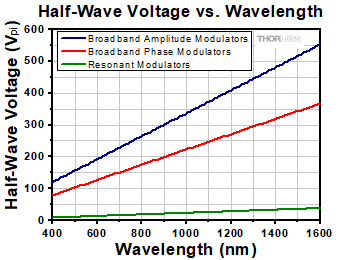
Click to Enlarge
Figure 1.1 EO変調器を駆動するのに必要な電圧(半波長電圧)は、光信号の波長に依存します。
赤と青の線は非共振型のEO変調器、緑の線は共振型変調器の特性を示しています。
共振型変調器の半波長電圧は、20 MHzタイプの典型的な特性です。
特長
- コンパクトなパッケージで高性能
- DC結合型の非共振またはAC結合の高Q共振型
- Ø2 mmの開口
- 4種類の波長帯域: 400~600 nm、600~900 nm、900~1250 nm、1250~1650 nm
- MgO添加ニオブ酸リチウム結晶
- SMA RF変調入力コネクタ
- DC~100 MHzの非共振帯域幅
- 標準的な20 MHzの共振型でご用意
- 共振周波数は0.1~100 MHzの間でご要望に応じてカスタマイズ可能
*400~600 nm(C4バンド)の変調器については、数Hz以上のAC変調でのみご使用ください。酸化マグネシウム(MgO)添加ニオブ酸リチウムはこの波長域の光に影響を受けやすく、印加されたDC電圧が徐々に打ち消されます。光の強度が大きいほど、DC電圧が打ち消される速度が速くなります。従って、変調器を所定の動作点で動作させるためのバイアスとしてDC電圧をかけることはできません。また、C4バンドでの動作は光損傷の影響を受けやすいため、結晶に恒久的な損傷を与える可能性がある過度のパワー密度を避けることが重要です。
DC結合の非共振型変調器
当社の非共振型EO変調器は、堅牢な筐体に収められたEO結晶で構成されており、DC~100 MHzのすべての周波数での動作用に最適化されています。 変調を行うには、RF入力のSMAコネクタに接続するための外部高電圧ドライバが必要です。ドライバHVA200は1 MHzまでの周波数にご使用いただけます。増幅器の仕様についてはHVA200「仕様」タブをご参照ください。-C4*(400~600 nm)、-C1(600~900 nm)、-C2(900~1250 nm)、-C3(1250~1650 nm)のARコーティング付きでご提供しております。コーティングの反射率の詳細については「グラフ」タブをご覧ください。
高Q共振型変調器
当社の共振型EO変調器は、高いQ値の共振回路を使用して、固定周波数ながら、非常に低い動作電圧で動作します。 当社の標準的な共振型の強度変調器および位相変調器は、-C1 ARコーティング(600~900nm)付きで、約15のQで20 MHzで動作します。カスタム仕様の共振周波数では、Q値が大きく異なることがありますのでご注意ください。コーティングの反射率の詳細については「グラフ」タブをご覧ください。カスタム品の共振周波数は0.1~100 MHzまでの周波数でご提供可能です。用途に応じた製品に関しては、当社までご相談ください。
ドライバとアクセサリ
このような非共振型の自由空間変調器では、ハイキャパシタンスな容量性であるため、駆動するのが困難な場合があります。当社の高電圧増幅器HVA200は、低ノイズで、±200 Vの出力と1 MHzの帯域幅を有し、これらの非共振型EO変調器を仕様の限界まで駆動することができます。400 Vの出力振幅により、波長が約1200 nmまでの非共振型の強度変調器と、全波長にわたる非共振型の位相変調器をフル変調することができます。また、振幅(強度)変調器のQuadrature Pointへの電気的補償を可能にする調整可能なDCバイアスを提供し、±200 Vの両極性出力振幅を効果的に利用します。
こちらの非共振型の変調器を1 MHzより高い周波数で駆動したり、より長い波長で駆動したりするには、容量負荷を駆動するのに十分な出力パワー、リニアリティおよび帯域幅を有する専用の増幅器が必要です。これらの変調器は標準的な50 Ωの負荷と同じようには動作しません。詳細は当社までお問い合わせください。
これに対し、共振型の変調器は共振周波数で50 Ωの負荷となるように調整された共振回路を有します。つまり、共振型の変調器では、50Ωインピーダンス用に設計された標準的な周波数発生器を使って、より低い電圧で駆動することができます。共振型の場合、周波数発生器は変調器の設計周波数とまったく同じ周波数に調整されていなければならないことにご注意ください。当社では、共振型変調器を0.1~100 MHzの間の任意の周波数で動作するようにカスタマイズ可能です。なお、Q値は共振周波数の関数のため、20 MHzモデルとは大幅に異なる場合があります。詳細については当社までお問い合わせください。
当社ではグラントムソン偏光子取付けアダプタのほか、当社のFiberBenchに取り付けるためのEO変調器用マウントもご用意しております(下記をご覧ください)。
変調器
| Item # | EO Amplitude Modulator EO-AM-NR-Cx | EO Phase Modulator EO-PM-NR-Cx | EO Resonant Modulator EO-AM-R-20-C1 | EO Resonant Modulator EO-PM-R-20-C1 | |
|---|---|---|---|---|---|
| Modulator Crystal | Lithium Niobate (LiNbO3) Doped with MgO | ||||
| Wavelength Range | -C4 | 400 to 600 nma | N/Ab | ||
| -C1 | 600 to 900 nm | ||||
| -C2 | 900 to 1250 nm | N/Ab | |||
| -C3 | 1250 to 1650 nm | N/Ab | |||
| Clear Aperture | 2 mm Diameter | ||||
| Input Connector | SMA Female | ||||
| Operation Frequency | Broadband | 20 MHzc | |||
| Half Wave Voltage, Vpi (Click for Plot) | 205 V at 633 nm (Typical) (Click for Graph) | 136 V at 633 nm (Typical) (Click for Graph) | 15 V at 633 nmd (Typical) (Click for Graph) | 10 V at 633 nmd (Typical) (Click for Graph) | |
| Extinction Ratio | >10 dB | N/A | >10 dB | ||
| Input Capacitance/Impedance | 14 pF | 50 Ohms | |||
| Max RF Input Power | N/A | 3 W (35 Vpp) | |||
| Max Optical Power Density | 2 W/mm2 @ 532 nm, 4 W/mm2 @ 1064 nm | ||||
下記のグラフは、当社の4つの誘電体コーティングの標準的なコーティングロットでの反射率を示しています。青い網掛けの部分はコーティングの透過率の高いスペクトル範囲を示しています。
電気光学(EO)変調器の概要
- はじめに
- 静的な位相リターダンス(SPR)
- EO位相変調器
- EO偏光変調器
- EO振幅(強度)変調器
- 振幅(強度)変調器におけるSPRの影響
- 振幅(強度)変調器の補償
- 補償方法
- 温度の影響を受けない振幅(強度)変調器
- 当社製の筐体内での動作
- EO変調器の駆動
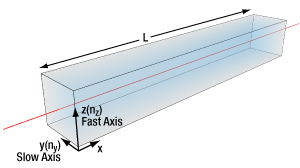
Click for Details
Figure 4.1 EO変調器に使用される典型的なXカットのLN結晶の概略図
はじめに
当社の自由空間型の電気光学(EO)変調器は、自由空間ビームを最大100 MHzの速度で変調することができます。酸化マグネシウム(MgO)添加のニオブ酸リチウム(LN)をベースとしており、効果的なEO応答性を有し、幅広い波長範囲でご使用いただけます。LNは複屈折性のある一軸性のEO結晶であり、一般的にFigure 4.1のような形状で使用されます。 この結晶は、結晶軸に対してカットされており、光はx軸に沿って伝搬し、駆動電圧はz軸方向に印加されます。これにより、位相変調器と振幅(強度)変調器のどちらのEO応答性も最大になります。以下では、関係する基本原理と、位相、偏光、振幅(強度)変調器におけるこの結晶の動作原理について説明します。
この結晶形状の重要な点は、光が結晶のy軸とz軸に沿った2つの直交する直線偏光でのみ伝播できることです。結晶には複屈折性があるため、2つの偏光は異なる屈折率(ny、nz)を有し、これにより伝搬速度が異なります。 屈折率の差(ny - nz)は、Δnで示されます。LNの場合、nyはnz よりも大きいため、y軸(スロー軸)に沿って偏光した光はz軸(ファスト軸)に沿って偏光した光よりも遅く進みます。その結果、光が結晶に入射すると、2つの直交する直線偏光は異なる速度で進み、結晶の長さLのΔn倍の光路差に相当する位相差で結晶から出射します。
静的な位相リターダンス(SPR)
結晶固有のΔnに起因する位相差は、一般に静的な位相リターダンスとして知られており、ここではSPRと表します。SPRは、Δn、波長λ、結晶の長さLの関数です。 係数が2piの場合はSPRをラジアンの単位で表し、係数が360の場合は度(°)の単位で表します。
SPR(ラジアン) = 2pi ⋅ Δn ⋅ L / λ またはSPR (degrees) = 360 ⋅ Δn ⋅ L / λ
LNは電気光学材料であるため、結晶のz軸に沿って電圧を印加すると、nyとnz が電気的に変調され、Δnが電圧の関数となり、位相および振幅(強度)変調器として機能します。SPRは位相変調器の動作には影響しませんが、振幅(強度)変調器の動作には重大な影響を与える可能性があることがわかります。 SPRは、環境の影響や、結晶およびEOモジュールの製造工程におけるばらつきの影響を受けます。したがって、SPRはモジュール固有であり、用途によっては、0~2piの範囲で変動する可能性があるため、SPRを測定し、補正する必要があります。*
*注:結晶から出射する直交した偏光の位相リターダンスについては、結晶が長く、位相リターダンスが2piの何倍にもなる場合についても大方を考慮に入れています。しかし、単一波長の動作では、実際に重要なのは0~2piの間の「正味」の位相リターダンスだけです。
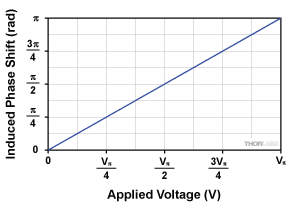
Click to Enlarge
Figure 4.3 位相変調器の出力位相の応答
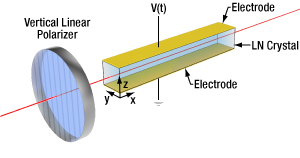
Click to Enlarge
Figure 4.2 位相変調器の構成図
EO位相変調器
最も効率的なLN位相変調器(PM)の使用方法では、Figure 4.2に示すように、印加電圧(z軸)と同じ結晶軸に沿って垂直に偏光した光を入力します。 光は主要な複屈折軸の1つだけに沿って直線偏光しているため、SPRの影響は受けず、出力偏光は垂直偏光のままです。多くの用途では、変調器の出力での伝搬よって発生する絶対位相遅延の影響は受けません。問題になるのは印加電圧による変調位相シフトのみです。
印加された変調電圧V(t)はnz を変調し、実効的な光路長を変化させることで出力光の位相シフトを変化させます。Vpiと呼ばれる半波長電圧は、pi (180°)の位相シフトを発生させるのに必要な変調電圧を示します。Figure 4.3は、印加されたV(t)による電圧誘起位相シフトを示しています。出力光の位相シフトが印加電圧に線形に比例していることがわかります。Vpiの実際の値は、多くの要因(例えば、結晶の寸法や光の波長)の関数となっています。標準的な当社のPMの場合、633 nmにおけるVpiは約150 Vです。
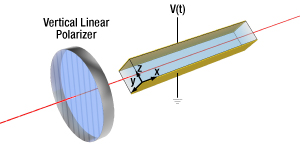
Click to Enlarge
Figure 4.4 偏光変調器の構成図
EO偏光変調器
偏光変調器では、結晶は変調器の筐体に対して45°回転しますが、入力偏光子は垂直方向のままです。Figure 4.4にこの構成を示しています。この結果、入力光は結晶のy軸とz軸に沿った2つの直線偏光に均等に分岐します。これらの2つの成分は、結晶中を伝搬する際に位相差を生じます。これは、上で説明したSPRと同じ原理です。ここでは、印加電圧によって発生する別の位相リターダンスについて説明します。これを電圧誘起位相リターダンス(VPR)と呼びます。
印加電圧V(t)は、y軸とz軸の両方に沿って屈折率を変化させ、結晶の位相リターダンスを変化させます。この付加的な電圧誘起の位相リターダンスはVPRと呼ばれ、次式のように全位相リターダンス(TPR)に影響を与えます。
TPR = SPR + VPR
ここでは、TPRが結晶の正味の位相リターダンスを決定します。例えば、この場合、TPRがpiに等しいとき、結晶は半波長板のような役割を果たし、水平な直線偏光を出射します。TPRがpi/2の場合、1/4波長板のように機能し、入射した直線偏光を円偏光に変換して出射します。その他の位相差では、様々な楕円偏光状態が得られます。このように、45°回転したLN結晶は、偏光変調器として機能します。Figure 4.5に標準的な例をいくつか示しています。

Click to Enlarge
Figure 4.5 入射偏光が垂直であると仮定した場合の、出射偏光状態と結晶によって発生する全位相リターダンスの関係
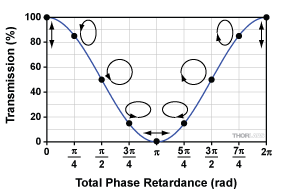
Click to Enlarge
Figure 4.7 2つの偏光子を平行に配置した、理想的な振幅(強度)変調器の透過率グラフ
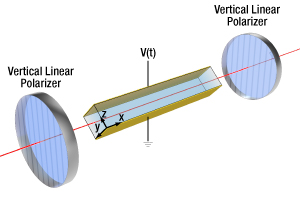
Click to Enlarge
Figure 4.6 2つの偏光子を平行に配置した振幅(強度)変調器の構成図
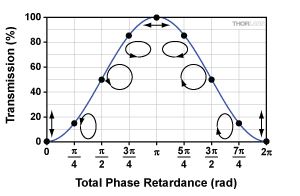
Click to Enlarge
Figure 4.9 2つの偏光子を垂直に配置した、理想的な振幅(強度)変調器の透過率グラフ
EO振幅(強度)変調器
振幅(強度)変調器を構成するには、直線偏光子を結晶の出射側に配置して、偏光状態の変化を振幅(強度)の変化に変換します。Figure 4.6では、2つ目の偏光板を1つ目の偏光板に対して平行に配置した構成例を示しています。出射側の偏光子を透過する光の割合は、結晶から出射する光の偏光状態に依存します。偏光子にアライメントされた偏光成分のみが偏光子を透過します。Figure 4.7に示すように、透過関数は次の式で与えられます。
T = cos2(TPR/2)
ここでは、前のセクションと同様に、TPR = SPR + VPRです。
振幅(強度)変調器の場合、Vpiはpi (または180°)のVPRを発生させるのに必要な電圧を示します。TPR = 0の場合、入射から出射まで偏光状態は変化せず、出力偏光子の透過は最大となります。TPR = piの場合、出射偏光は水平に変化し、出力偏光子の透過は最小となります。さらにTPRを2pi (または360°)に調整すると、透過率は再び最大になります。なお、cos2透過関数は周期的であるため、2piの倍数であれば透過率は同じであることにご注意ください。
また、Figure 4.8に示すように、出射側の偏光子を水平方向(より一般的には、入射側の偏光子に対して垂直)に配置した場合、Figure 4.7の曲線はpiだけ水平軸に沿って移動します。この結果、Figure 4.9の透過関数のようになり、TPR = piの時に最大透過率となります。
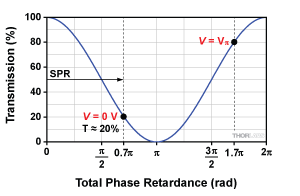
Click to Enlarge
Figure 4.10 上のグラフは、任意のSPRが透過応答性に対して与える影響を示しています。
振幅(強度)変調器におけるSPRの影響
実際には、SPRの値は予測できないため(0~2piの間の値になる可能性があります)、最大透過率はV = 0 Vでは発生しない可能性があります。SPRは、波長、温度、結晶の正確な寸法などの多くの要因の関数となっています。箱から出した直後のEO変調器のSPRはおそらくゼロ以外です。つまり、V = 0 Vの場合、透過率は0~100%のいずれかの値となっています(反射と吸収による損失は無視します)。
Figure 4.10の透過率曲線はSPRの効果を示しています。この例ではSPRを0.7piとしていますが、変調器のSPRは0~2piの間であればどこでもよいということに注意ください。この例では、0.7piのSPRで動作点(V = 0 V)の透過率を約20%に設定しています。したがって、Vpiの印加電圧時はSPRにVPRのpiを追加し、相対透過率は約80%になります。この例でSPRが0.7piとすると、最初の透過率の最小値に達するには、さらに0.3piのVPRを追加する電圧を印加する必要があります。あるいは、最大透過率に達するために、1.3piのVPRを誘発する電圧を追加する必要があります。
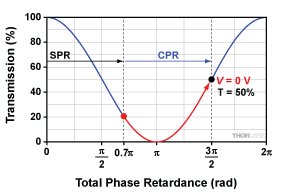
Click to Enlarge
Figure 4.11 上のグラフは、電圧の透過応答性に対して任意のSPRが与える影響を示しています。CPRがSPRに追加され、新しいV = 0 V動作点が設定されます。
振幅(強度)変調器の補償
SPRは0Vで任意の透過率を得られますが、多くの用途では変調器をpeak (T = 100%)、quadrature (T = 50%)、null (T = 0%)のような特定の伝送点に設定する必要があります。このような場合、目的の動作点に到達するためにSPRを補正しなければなりません。これは、補償位相リターダンス(CPR)を追加して行います。CPRを追加する方法については、次のセクションで説明します。TPRには3つの要素があります。
TPR = SPR + VPR + CPR
Figure 4.11 は透過関数と、前のセクションで使用したゼロではないSPRを示しています。この例では、0.8piの補償を追加してquadrature動作点(すなわち、V = 0 Vにおける、TPR = 3pi/2およびT = 50%)としています。任意の動作点に達するために、任意の値の補償を追加または差し引けます。
また、調整可能な補償板を必要としない特定の波長用に、カスタム仕様の変調器を作成することも可能です。詳細については当社までお問い合わせください。
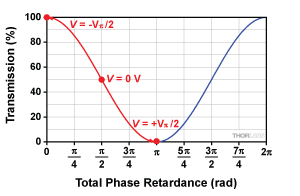
Click to Enlarge
Figure 4.13 :quadrature動作点における振幅(強度)変調器の透過性能
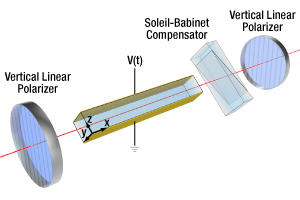
Click to Enlarge
Figure 4.12 光補償機能付き振幅(強度)変調器の概略図
補償方法
お使いの用途における特定の動作点を設定するために補償が必要な場合、2つの主な補償方法(電気的または光学的補償)のどちらかを用いることができます。電気的補償方法は、変調電圧に加えてDC電圧(VDC)を印加するだけです。Figure 4.11の例では、透過率が50%の地点に到達するために0.8VpiのDC電圧を加える必要があります。CPRの式は次のようになります:
CPR = pi ⋅ VDC / Vpi = 0.8pi
静的なDC電圧を調整して印加することでCPRを加えることができます。この電気的なDC補償方式はほとんどの波長でうまく機能しますが、短い波長(400~600 nm)の光は、印加されたDC電界を打ち消す内部電界を発生させる可能性があります。
しかし、もう一つの方法である光学的補償は、すべての波長で一様に機能します。通常、これにはバビネソレイユ補償板のような補償量の調整が可能な波長板を使用します。Figure 4.12に示すように、補償板を結晶の軸にアライメントすると、光学的に調整可能なCPRが発生します。これは、純粋な電気的補償のために非常に高い電圧が必要となるような、長波長での非共振型の振幅(強度)変調器への使用に適しています。
光学的補償の利点の一つは、完全変調に必要な絶対電圧を低減できることです。 幅(強度)変調器の例では、動作点をpeak (T = 100%)またはnull (T = 0%)に設定すると、フルVpi電圧を最小透過率と最大透過率の間で変動させれば良いことになりますす。一方、動作点をquadrature (T = 50%)に設定すると、必要な電圧範囲は-Vpi/2 to +Vpi/2となります。これは、駆動電圧の絶対値が実質的に半分になることを意味しますが、Figure 4.13に示すように、VPRの追加と削減の両方が可能な双極性の電源が必要となります。
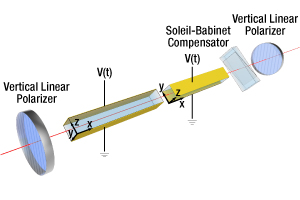
Click to Enlarge
Figure 4.14 光補償機能付き温度補償振幅変調器の概略図
温度の影響を受けない振幅(強度)変調器
LNベースの変調器の厄介な問題の一つは、熱光学効果によって結晶の屈折率が温度依存性を持つことです。当社の振幅(強度)変調器には、1つ目の結晶に対して90°回転させた2つ目の結晶が付いているため、出力偏光状態が温度によってドリフトしません。Figure 4.14はこの構成を示しています (注:当社の位相変調器(PM)には長さ40 mmの結晶が1つ、振幅(強度)変調器(AM)には長さ20 mmの結晶が2つ入っています)。
各結晶は次式のように独立してSPRに影響を与えます:
TPR = SPR1 + SPR2 + VPR + CPR
ここで、SPR1は1つ目の結晶、SPR2は2つ目の結晶から発生する静的な位相リタ ーダンスです。2つ目の結晶は90°回転しているため、その複屈折軸(y、z)も回転しています。したがって、2つ目の結晶のSPRは1つ目の結晶のSPRを補償します。結晶の長さが完全に一致していれば、SPR1 = -SPR2となり、以下の式が成立します。
TPR = VPR + CPR
このようにして、整合した結晶はSPRの熱変動を補償し、変調器の温度感度を0.01 rad/°C以下にします(単位は°Celsius)。この整合した結晶はVPRを補償せず、SPRのみを補償するため、変調効率には影響を与えません。ただし、製造上の制約により、SPRが多少残ります。結晶の長さがμm-scaleスケールの小さな不一致であっても、SPRは0~2piの値になる可能性があります。整合した結晶のペアにより、熱補償が効果的に行われますが、動作点を設定するには、前のセクションで説明した補償方法のいずれかを使用する必要があります。
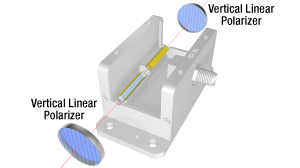
Click to Enlarge
Figure 4.16 EO変調器の筐体に対する偏光子の向き(振幅変調器の場合)
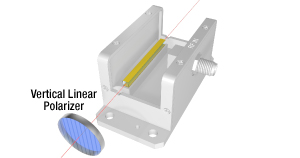
Click to Enlarge
Figure 4.15 EO変調器の筐体に対する偏光子の向き(位相変調器の場合)
当社製の筐体内での動作
Figure 4.15と4.16は、変調器の筐体に対するLN結晶と直線偏光子の向きを示しています。EO変調器には、LN結晶(振幅変調器には2個)と外部駆動電圧を印加する電子回路だけが入っています。前のセクションで説明した直線偏光子や光学補償板は含まれていません。位相変調器は、別途、垂直方向に配置した入射側偏光子(または偏光レーザ光源)のみを必要としますが、振幅(強度)変調器は入射側偏光子と出射側偏光子の両方を必要とします。
Figure 4.15は標準的な位相変調器(PM)を示し、Figure 4.16は振幅(強度)変調器(AM)の構成を示しています。PMの結晶は2つのAMの結晶と同じ長さなので、どちらのモデルでも、任意の波長に対する半波長電圧は同じくらいの大きさです。より正確には、位相変調器の単一偏波では、振幅(強度)変調器の2つの直交偏波間の正味のEO係数よりも高い有効EO係数となるため、PMは常にAM同等よりも低いVpiを有します。
レーザ光源がすでに垂直直線偏光であれば、どちらのタイプの変調器でも入力側の偏光子は必要ありません。これらの変調器を別の偏光スキームで動作させることも可能ですが、その方法についてはここでは説明していません。詳細については当社までお問い合わせください。
EO変調器の駆動
自由空間型変調器の駆動は、特殊な電子回路が必要となります。当社の高電圧増幅器HVA200は、低ノイズで、±200 Vの出力と1 MHzの帯域幅を有し、一定の動作条件において、当社の広帯域非共振型EO変調器を駆動するのに適しています。400 Vの出力振幅により、波長が約1200 nmまでの非共振AMと、全波長にわたる非共振PMをフル変調することができます。また、振幅(強度)変調器のquadrature動作点への電気的補償を可能にする調整可能なDCバイアスを提供し、±200 Vの両極性出力振幅を効果的に利用します。
非共振型の変調器を1 MHzより高い周波数で駆動したり、より長い波長で駆動したりするには、十分な出力パワー、直線性および帯域幅を有する専用の増幅器が必要です。さらに、非共振型変調器の場合、ドライバは純粋な容量性負荷を駆動できることが必要です。これらのデバイスは標準的な50 Ωの入力インピーダンスは有していません。
当社では、入力電圧要件を低減した共振型変調器もご用意しております。これらの変調器(AMとPMの両方)には、特定の周波数で共振する内部回路が付属しています。これにより、外部正弦波駆動信号の振幅を、EO結晶が必要とする高い電圧レベルまで効果的に増幅されます。トレードオフは、これらの変調器が1 MHz~100 MHzの特定の設計周波数でしか動作しないことです。20 MHzで動作する共振型変調器は標準品としてご用意しており、他の周波数についてのご要望も承ります。
共振型変調器と非共振型変調器の詳細については製品ページをご覧いただくか、当社までお問い合わせください。
| Posted Comments: | |
user
(posted 2025-09-18 16:46:57.53) Hello,
I have some questions on (non-resonant) EO-AM-NR-C2, which I purchased. I made some attempts to measure the modulation depth of the crystal using a resonant circuit. However, I have not yet achieved maximum transmission in the cross-polarizer configuration. I had a few questions in mind to debug the issues.
1. Since there are two crystals inside, should the actual applied voltage be 2*Vpi for pi retardation?
2. Does the TPR equation remain the same as that for 1 crystal? Or is everything almost doubled or halved? tdevkota
(posted 2025-11-03 10:19:39.0) Thank you for contacting Thorlabs. While our amplitude modulators consist of two matched lithium niobate crystals, the voltage required for pi (or 180°) phase retardance is still Vpi and the TPR equation remains the same. Please refer to the EO Modulator Intro tab for more information. I have reached out to you directly to discuss this in more detail. LEE Sangin
(posted 2025-06-13 11:56:18.823) Hi, I'm Sangin LEE, graduate student in Seoul National University.
I have a question about extinction ratio of EOM.
Is it correct that extinction ratio formula is
ER(dB) = 10*log10(Horizontal polarized light intensity / Vertical polarized light intensity)
when I put vertical polarized light and apply half wave voltage?
It is written that ER is better than 10dB.
Is it correct that intensity ratio is better than 10:1?
Thank you.
Best Regards,
Sangin LEE.
Physics and Astronomy
Seoul National University tdevkota
(posted 2025-06-13 04:33:01.0) Thank you contacting Thorlabs. The extinction ratio is measured by placing the modulator between crossed polarizers and adjusting the optical or electrical bias to find the maximum and minimum transmission points. ER is defined as the ratio of maximum to minimum transmitted power. Our resonant EO modulators are specified for >10 dB ER, a conservative figure, as typical performance is often higher due to our high crystal quality standards. 旺 陈
(posted 2025-05-30 04:07:08.17) 我们组(来自华南师范大学)想购买一台电光调制器:想用电光调制器将700-1100(近红外)的连续激发光调制成脉冲光,且电光调制器能输出对应的trigger信号到TCSPC,目的是为了测10ns-100μs(或者1ns-1ms)的寿命。请问如果购买这个电光调制器,能实现我们想要的功能吗?且工程师包安装好。最好加微信或者邮箱联系(cw18162425781 1846115126@qq.com,手机静音不一定接) EGies
(posted 2025-06-04 11:47:35.0) Thank you for contacting Thorlabs about your request regarding using a freespace EO modulator for modulating CW light with wavelengths from 700-1100nm into pulses with 10ns-100μs pulse widths. I have reached out to you directly regarding this. Zeyan Zhang
(posted 2025-05-29 02:26:59.597) Hello, I would like to know what the specific frequency range that can be applied for EO-PM-NR-C2 is? I would like to apply a frequency of 600 MHz to it. Could this be done? Or does your company have any such recommendations? tdevkota
(posted 2025-06-05 02:38:49.0) Thank you for contacting Thorlabs. Our free-space amplitude modulators are optimized for speeds up to 100 MHz. We do not have free-space EO modulators that can go up to 600MHz unfortunately. However, we offer fiber-coupled intensity (and phase) modulators for speeds up to 40 GHz. LEE Sangin
(posted 2025-05-10 17:24:33.627) Hi, I'm Sangin LEE, graduate student in Physics, Seoul National University.
I'm interested in amplitude modulator.
Is it possible to coat a wider range of wavelength, such as 600-1250nm?
Thank you.
Sincerely, Sangin LEE. tdevkota
(posted 2025-05-13 10:15:16.0) Thank you for contacting Thorlabs. Requests for customization of our stock items can be made by emailing us at techsupport@thorlabs.com. I have reached out to you directly to discuss the feasibility of this request. Lee Jeonghan
(posted 2025-03-12 18:19:43.207) Hello, I'm looking for an EOM for polarization control of single photons of around 580 - 600 nm at 80 MHz excitation.
Can I use a non-resonant EO amplitude modulator for this purpose?
I wonder if the non-resonant EO amplitude modulator you provide can work at 80 MHz, especially in regard with high speed voltage switching.
IWe appreciate your assistance. ksosnowski
(posted 2025-03-27 01:15:00.0) Hello Lee, thank you for reaching out to us. The amplitude modulators can be configured as polarization modulators. The non-resonant modulators can be driven at 80MHz with the proper electronics however this is faster than our HVA200 amplifier can support. Resonant modulators remove the need for an amplifier and can be driven at high speeds with an RF signal generator directly. However the limited 1MHz bandwidth around the resonance means they are primarily meant for continuous sinusoidal signals rather than arbitrary switching. I have reached out directly to discuss your application in further detail. LEE Sangin
(posted 2025-02-27 13:33:06.403) I have two questions. First, if a phase modulator is used with a 45-degree rotation, does it function the same as an amplitude modulator?
Second, if a Resonant EO Modulator (Resonant Amplitude Modulator) is designed for 80 MHz with a C1 coating (600–900 nm), what would be the expected half-wave voltage, extinction ratio, and price? tdevkota
(posted 2025-03-03 04:12:37.0) Thank you for contacting Thorlabs. While phase modulators can be used as amplitude modulators with additional polarization optics, they are not highly effective due to thermal birefringence and wavefront distortion issues. The half-wave voltage varies with resonant frequency, and for a standard 80 MHz resonant phase modulator, I would expect it to be around 30 V. I have reached out to you directly with additional details. Yang Yang
(posted 2024-05-14 14:26:18.763) We recently bought a EO-PM-R-20-C1 for PDH lock. How can we increase the Q factor by modifying the mode-matching circuit to further reduce the half-wave drive voltage. ksosnowski
(posted 2024-05-16 04:32:43.0) Hello Yang, thanks for reaching out to Thorlabs. We hand-tune each of our high-Q resonators to the desired frequency, making a best effort to maximize Q. To drive to your desired modulation depth you may need to use an additional 50 Ω amplifier. Please contact Thorlabs Tech Support if you have concerns about driving your modulator. We have reached out directly to discuss your application in further detail. ksosnowski
(posted 2024-05-16 04:32:43.0) Hello Yang, thanks for reaching out to Thorlabs. We hand-tune each of our high-Q resonators to the desired frequency, making a best effort to maximize Q. To drive to your desired modulation depth you may need to use an additional 50 Ω amplifier. Please contact Thorlabs Tech Support if you have concerns about driving your modulator. We have reached out directly to discuss your application in further detail. user
(posted 2024-04-18 15:18:45.663) I would like to use the 400-600nm EOM EO-AM-NR-C4 for amplitude modulation at the full modulation rate of 100 MHz for a 10mW 405nm laser beam. Is this feasible? What is V_pi for this wavelength and EOM? ksosnowski
(posted 2024-04-26 09:50:08.0) Hello, thanks for reaching out to Thorlabs. The typical Vpi vs Wavelength can be found under the "Overview" tab above. For 405nm, this is close to 125V. The non-resonant models can be driven upwards of 1MHz however our HVA200 driver is only capable of driving the 14pF capacitive load up to 1MHz. We do also make resonant modulators up to 100MHz, which allow a much lower control voltage to drive the system, though the frequency performance is narrowband around the designed resonance. Operating EO-AM-NR-C4 at 100MHz would prove challenging as a very high current would be required to charge/discharge the capacitance in the 10ns period for this modulation, much higher than what our HVA200 can supply. A resonant amplifier model can help with this. I have reached out directly to discuss your application in further detail. Jeremie Margueritat
(posted 2024-03-27 21:51:42.913) I envisage to purchase teh EO-AM-NR-C4. However I read that in this range the AM modulators operating in the
-C4 band (400 - 600 nm) should only be used for AC modulation above a few Hz. I would like to work up to 500kHz in Amplitude modulation with 515 nm laser. Is the EO-AM-NR-C4 adapted for this use?
Best regards ksosnowski
(posted 2024-03-28 12:00:54.0) Hello Jeremie, thanks for reaching out to Thorlabs. You are correct that the -C4 version should only be used for AC modulation, any DC field will end up canceled by the applied light source. This means for any DC biasing of the modulator a physical waveplate should be used instead. On the other non-resonant modulator versions, a DC voltage can be applied to bias the retardance of the crystal. 500kHz is fine as it is well above the DC range of the device and is within the modulation range of our HVA200 driver as well. I have reached out directly to discuss this application in further detail. Seungeun Oh
(posted 2024-01-24 23:50:08.753) Which direction relative to the housing is the fast axis of the crystal in Resonant EO Modulators? jdelia
(posted 2025-11-04 03:31:29.0) Thank you for contacting Thorlabs. In the -PM modulators, the fast axis is oriented in the vertical direction. Because the two crystals in the -AM modulators are rotated by 90 degrees with respect to each other, there is no single fast axis with respect to the housing. Alexia RAVAILLE
(posted 2024-01-09 07:57:29.123) Dear Tech support team,
My question might seem stupid but I have a non resonant PM EO-PM-NR-C1 and I would like to know its input impedance. In the datasheet, it's specified that the resonant has 50 ohms of input impedance and the non resonant have 14pF capacitance but I can't find the info about the impedance of the non resonant. Does it mean that it's only capacitance with no impedance when non resonant ?
Also, how do we know if we have a resonant or a non resonant PM if we've lost the packaging of the component ?
Thank you and happy new year. ksosnowski
(posted 2024-01-10 02:47:40.0) Hello Alexia, thanks for reaching out to us. If the EOM is non-resonant, then you will be able to modulate the phase from DC to 100 MHz or so, as long as your driver can support it. If resonant, then modulation will only be possible near the resonance frequency (20MHz for our standard model). As long as you operate safely below the RF input maximum (3 W, 35 Vpp), you will not damage the resonant modulator. On resonance, the EOM will have a nearly 50 Ω impedance, whereas far from resonance it will have a highly reactive impedance, and will burn out if the 50 Ω resistance dissipates too much RF power. Since the non-resonant EOMs have a ~14 pF impedance (purely reactive aside from small parasitics) they do not dissipate power. This is why we don't spec a Maximum RF Input Power for the non-resonant modulators. Guangying Ma
(posted 2023-08-16 12:47:50.81) Hello,
I have bought the EO-PM-NR-C4. I am using a 488 nm (20 mW) laser as the input. Then I calculated the Vpi is 152.0 V. I applied a AC power, with -152 and 152 V, 1000 Hz square wave as the driving voltage. I found that the polarization of the input light was changed, however, the changed angle is very small, which is smaller than 15 degree. Could you help me to find what is the problem? Is the driving voltage I used is correct?
Thanks. ksosnowski
(posted 2023-08-29 05:48:04.0) Hello Guangying, thanks for contacting us. This is the correct Vpi however if the driver is not suitable it could struggle to switch the voltage fast enough resulting in effective peak voltage attenuation or if the input polarization alignment is incorrect this can result in a lack of dynamic range with the EO modulator. Our HVA200 driver is suitable for this application based on the amplitude, waveform, and total bandwidth. In case your laser system is unable to be rotated to change the input polarization, a halfwave plate can be used to effectively bias the input polarization angle before entering the EOM. I have reached out directly to discuss your application in further detail. Jihoon Kang
(posted 2023-04-21 11:47:07.397) Can you tell me the "maximum laser durability" (ex: 2.5 MW ...) of the modulator?
I also want to know about the "wavelength coverage". cdolbashian
(posted 2023-04-26 09:29:57.0) Thank you for contacting us Jihoon. All of this information (and more) is available above in the "Specs" tab. Additionally I would read through the document in the "Lab facts" tab as we have documented some testing with these devices. Cristian Tong
(posted 2023-01-01 02:37:58.223) Hello, I would like yo ask you about the insertion loss of the free space electro optic phase modulator EO-PM-NR-C1. This parameter is not specified in the specs of the device.
Thank you cdolbashian
(posted 2023-01-10 02:36:19.0) Thank you for contacting us Cris! If you are referring to the transmission vs reflection, we would expect ~.2% reflection over the AR coating range, and >98% transmission through the crystal (again, while operating within the AR coating range). I have reached out to you directly to discuss this inquiry. stefano chiodini
(posted 2022-09-09 10:20:53.787) Good morning, I have the following question.
For my project I need to use the C4-C1-C2-C3 EOM-AM of Thorlabs to cover a range from 400 nm to 1600 nm. The Vpi required voltages go from about 100 V to 600 V following your graph.
Since we could have troubles in covering the 300 V-600 V I was wondering if a phase EOM could be used... They have indeed lower Vpi voltages but I do not really understand the difference with the AM-EOM. Could you please help me out in this? Following your phase EOM description: "the value of n⊥ is not a factor". What does it mean? that only the parallel beam goes through?
Thank you,
Stefano jdelia
(posted 2025-12-18 01:02:09.0) Thank you for contacting Thorlabs. This depends on what you are trying to accomplish. Amplitude modulators are for modulating intensity and phase modulators are modulating phase. While it is technically possible to use a phase modulator as an amplitude modulator, it might not work great for several reasons. We would be happy to facilitate a conversation regarding this. Additionally, we could look into custom resonant amplitude modulators which would have much lower V_pis. For further information, you may reach out to your local technical support team at Europe@thorlabs.com. Michael Lim
(posted 2022-07-19 11:40:28.22) Can this phase modulator be adapted for use at 2000nm? jgreschler
(posted 2022-07-22 04:21:26.0) Thank you for reaching out to Thorlabs. We do have custom wavelength capabilities for our EOM product line, you can request a quote by emailing techsupport@thorlabs.com. I have reached out to you directly with more information. Farooq Khaleel
(posted 2021-10-04 18:12:37.967) Dear Sir/Madam,
I hope that this message finds you well.
Please could you inform me about if these EO modulators supports bidirectional modulation? I mean could I apply the incident laser from the output port and extract the output from the input port? and vice versa?
In addition, what is the minimum detectable input power in Watt?
Thank you very much.
Yours sincerely, YLohia
(posted 2021-10-07 08:20:17.0) Hello, thank you for contacting Thorlabs. Yes, the modulators are bidirectional. These non-resonant modulators are a purely capacitive load- the power does not dissipate in the crystal. We do not specify an upper limit for how much power can be sent through the modulator. In these cases the driver is typically the limit on power, not the modulator. For our resonant modulators, e.g. EO-PM-R-20-1, the max RF power that can be sent through the device is 3W. If you are inquiring about the minimum optical input power, the modulators have no minimum input power (this is true for both the resonant and non-resonant models). The light is attenuated by a fixed amount depending on the applied voltage and the wavelength of the light. Think of it as a variable attenuating filter; it will absorb some percentage of the light regardless of how little power is put through it. The modulator is not the limit on how little power can be used in a system; it depends on how sensitive the detector is. T I
(posted 2021-09-24 12:11:21.52) Dear Thorlabs support team, I am using your free space LN modulators and need to know the exact crystal lengths. We could find some info in your previous replies to feedback comments, but it seems there is a conflict between the two responses below.
YLohia (posted 2019-11-12 11:18:13.0)
Our PM use only one LN crystal of 20mm length, as opposed to two orthogonal 20mm (adding up to 40mm) crystals used for AM
nbayconich (posted 2017-05-03 10:04:19.0)
The crystal length of our free space Amplitude modulators is 20mm. The LiNbO3 crystals in our free space phase modulators are 40mm in length.
Could you tell us the exact crystal lengths of the amplitude and phase modulators? YLohia
(posted 2021-10-08 03:03:04.0) Hello, thank you for your feedback. I seemed to have made a typo on my response posted on 2019-11-12 11:18:13.0 (which I have now corrected). The phase modulators only use one crystal of 40 mm length. The amplitude modulators use two orthogonal crystals, each 20 mm long, adding up to a total of 40 mm length. My sincere apologies for any confusion caused by the previous post. dongxu Bai
(posted 2021-06-01 16:45:52.517) 调制信号的频率范围是什么
What is the frequency range of the modulated signal YLohia
(posted 2021-06-04 02:48:43.0) These modulators can be used from DC to 100 MHz. user
(posted 2021-05-24 18:52:46.0) Hi, could you tell me the price of the customized resonant EOM? Thanks. YLohia
(posted 2021-05-27 02:39:22.0) Hello, custom items are quoted by emailing your local Thorlabs Tech Support team (in your case, techsupport.uk@thorlabs.com). We will discuss the pricing directly. Michal Pawlak
(posted 2020-10-24 02:46:00.01) Dear Sir Madam
could you please explain my problem.When I will buy your EO amplitude modulator with driver I can modulate between DC 100 MHz. Or frequency is limit to 1 MHz as is stated in description of driver.
best wishes
Michal YLohia
(posted 2020-10-26 09:34:30.0) Hello Michal, thank you for contacting Thorlabs. The EOM itself is capable of modulating up to 100 MHz but the HVA200 limits that capability to 1 MHz. Haechan An
(posted 2020-10-18 18:53:46.15) Hi, I want to create sidebands at 780 nm using EO-PM-NR-C1 with a modulation frequency of around 20 MHz. But it turned out that we need high voltage to see those sidebands easily. (Probably need a voltage higher than 50 V but we only can go up to 10 V right now.) Can you tell me the equivalent electric circuit of EOM so I can build a resonant RLC circuit using resonators and inductors? Or is it enough to assume the EOM as a 14 pF capacitor? YLohia
(posted 2020-10-23 03:34:35.0) Hello, thank you for contacting Thorlabs. The modulator can be modelled purely as a 14pF capacitor. The exact capacitance is given on the serialized test sheet that ships with each unit. user
(posted 2020-10-19 16:59:00.947) 我想要用这个电光调制器实现633nm激光的偏振调制,请问能够实现吗?请问电光调制器配置有偏振片吗? YLohia
(posted 2020-10-19 03:12:46.0) An applications engineer from our team in China (techsupport-cn@thorlabs.com) will reach out to you directly. 宝利 刘
(posted 2020-06-15 08:20:11.92) 我想利用这个EOM调制f=76MHz脉冲激光,调制频率为f/4,即2个脉冲透过,2个脉冲不透过。这个调制频率f/4由激光器的频率锁定。这种可以定制吗? YLohia
(posted 2020-06-15 09:53:28.0) Thank you for contacting Thorlabs. An Applications Engineer from our Tech Support team in China will reach out to you directly. Caroline Muellenbroich
(posted 2019-11-12 09:43:11.917) Hi Thorlabs team,
I am trying to modulate the power of a pulsed 1300nm laser with a EO-PM-NR-C3 using a voltage amplifier that has an output of +/- 150V.
The half wave voltage for my wavelength is 300V which I cannot supply. Am I right in thinking that by supplying 150V, and using a quarter waveplate before the input, that is inputting ciruclarly polarised light into the EOM, I should be able, with a Glan Thompson at the output of the EOM, to modulate the output power of my laser? Many thanks. YLohia
(posted 2019-11-12 11:18:13.0) Hello Caroline, thank you for contacting Thorlabs. Your understanding is correct regarding the use of the waveplate. By using a quarter waveplate on the input, you can cut down the V_pi in half. We have more information regarding this technique in the "Lab Facts" tab of this page. That being said, we do not recommend attempting amplitude modulation with a phase modulator.
While PMs can be used as AMs with additional polarization optics, they will not make good amplitude modulators. Our PM use only one LN crystal of 40mm length, as opposed to two orthogonal 20mm (adding up to 40mm) crystals used for AM, that eliminates static birefringence. These crystals exhibit thermal birefringence, which means that a phase modulator will have thermal drift issues when used as an amplitude modulator. One good question would be why phase modulators exist since amplitude modulators would do exactly the same thing while offering better performance due to the lack of thermal issues. The reason is that thermal effects are relatively insignificant for PM due to the input beam being polarized along one of the crystal axes. This thermal drift produces a DC phase shift (equivalent to adding few um of OPL). Our phase modulators are made with MgO-doped lithium niobate crystals. This material works well for phase modulation, and the MgO doping helps to increase the material's resistance to photorefractive damage. However, one drawback to this material is that it exhibits increased wavefront distortion (as opposed to undoped lithium niobate). For most phase modulation applications, wavefront distortion of the optical beam does not present any problems (can cause problems when being used for interferometry resulting in poor phase contrast), but when used as an amplitude modulator, the wavefront distortion causes poor extinction ratios. kar-hooi_kuan
(posted 2019-02-20 06:15:13.65) Hi,
I'm interested in Amplitude Modulations EO Modulators. I would like check with you if the optical input can be connectorized with FC/APC connectors? I will need it to be connectorized. If it can be connectorized, could you please quote me together with the EO MOdulator High Voltage driver?
By the way, what is the maximum modulation frequency supported by this EO-PM-NR-C3?
Thanks a lot. YLohia
(posted 2019-02-21 08:48:45.0) Hello, thank you for contacting Thorlabs. Unfortunately, this cannot be connectorized as it requires a collimated free space beam in order to work properly. What wavelength are you hoping to use this for? If it's around the 1550nm range, I would recommend looking into our fiber coupled LN modulators here : https://www.thorlabs.com/newgrouppage9.cfm?objectgroup_id=3918. These can go up to 10 GHz, whereas the model you were interested in is suitable up to only 100 MHz.
Another option would be using a FiberBench of at least 70mm length with two Fiberports to make the free space EOMs fiber-compatible. Please see the bottom of this page for more information. zenin
(posted 2019-02-20 10:42:19.48) Hi,
I am investigating the project of building fast noise eater (faster than 1 MHz) for my free-space lasers by using your EO modulators. I am wondering, can you make EO modulator witohut anti-reflection coating? It is because I have several sources from in VIS and NIR ranges (600-1800 nm). Also I am wondering, can Thorlabs make such noise eater, and if yes, how much will it cost? Looking forward to your reply.
Best,
Vladimir YLohia
(posted 2019-02-21 09:02:09.0) Hello Vladimir, thank you for contacting Thorlabs. Quotes for custom modulators can be requesting by emailing your local Thorlabs Tech Support group (techsupport.se@thorlabs.com in your case). We will reach out to you directly to discuss the possibility of offering uncoated crystals.
That being said, please note that the total transmission will suffer greatly when using uncoated crystals. The amplitude modulators consist of two lithium niobate crystals, which means that the reflectivity will be quite high from a total of four surfaces since the optical index is about 2.3. When this happens, you can get multiple reflections within the crystal that see different amounts of modulation and can interfere with each other. The workaround for this would be to tilt the crystal as far as possible and then prevent the reflected beams from getting in the system by clipping them with an aperture or edge of some kind.
Unfortunately, we are unable to offer a fully designed 1 MHz noise eater at the moment, though it is something that I will suggest on our internal engineering forum. vinx-d
(posted 2019-01-17 04:35:15.51) I am going to use the HVA200 in order to amplify a input voltage. I was wondering if I can amplify the bias without using any input. YLohia
(posted 2019-04-01 04:43:39.0) Hello, thank you for contacting Thorlabs. I reached out to you at the time of the original post in order to gather more information about your request. Please send us an email at techsupport@thorlabs.com if you did not receive our email. kkss0330
(posted 2018-10-11 00:29:20.047) Hello, I bought EOM that model number of EO-AM-NR-C4, I will operate laser source wavelength 633nm. I know that this supports a wavelength band from 400 to 600nm, can EOM work well from 633nm? YLohia
(posted 2018-10-11 09:53:27.0) Hello, thank you for contacting Thorlabs. The -C4 coating typically has a reflectivity of around 0.5-0.7% at 633nm. Since you already have the EOM with you, we recommend that you test it out yourself to see if the change in performance fits your requirements. baudin
(posted 2018-03-27 16:27:15.35) Hello, the specs say the load impedance is 14 pF, can you provide the loss angle function of frequency? YLohia
(posted 2018-04-03 10:26:35.0) Response from Yashasvi at Thorlabs USA: Hello, thank you for contacting Thorlabs. While we don't have a loss angle as a function of frequency spec at the moment, we do have a spec for the loss tangent @ 400 °C:
x-axis: tan(δ) = 0.0006
y-axis: tan(δ) = 0.001
We have seen values around ~0.003 for the loss tangent at 1 GHz. This is a property of the material (lithium niobate) itself. parksj003
(posted 2018-01-28 22:03:42.99) I am going to use a HVA200 with EO-AM-NR-C1 for fast light intesnity modulation (on/off).
I am wondering the rise/falling time of HVA200 and the time dealy between input and output. nbayconich
(posted 2018-02-23 10:49:58.0) Thank you for contacting Thorlabs. The typical rise/fall time of the HVA200 alone is about 350ns at 1Mhz, however the HVA200 is typically limited to the slew rate which is 400V/µs. We have not yet tested time delay when using an intensity EO modulator with the HVA200 at the moment. tanmaybhwmk3
(posted 2017-11-15 01:51:46.267) Hi. What is the expected insertion loss of the EO-AM? tfrisch
(posted 2017-11-20 05:18:05.0) Hello, thank you for contacting Thorlabs. The loss through the modulator is <1dB, typically about 0.5dB. fyk15isy
(posted 2017-10-02 15:09:40.037) Hi! I am looking for an EOM to do an amplitude modulation of 880 nm beam from OPO with an average power of 1 W. (It actually produces 5 ps pulses with 80 MHz repetition rate). I plan to focus the beam into the EOM since my beam diameter is too large for this EOM. Will this EOM be able to withstand this power when using short focal length lenses (50 - 100 mm lenses)? tfrisch
(posted 2017-11-14 02:48:07.0) Hello, thank you for contacting Thorlabs. These EOMs are intended to be used with a collimated input. If there is significant convergence or divergence, this would give an angular dependence on the optical path length which would affect the retardance and therefore amplitude modulation. I will reach out to you directly about damage and other methods of limiting the beam diameter. user
(posted 2017-05-02 11:05:15.013) What's the LiNbO3 crystal length of EO-AM-NR-C1? 20 mm? nbayconich
(posted 2017-05-03 10:04:19.0) Thank you for contacting Thorlabs. The crystal length of our free space Amplitude modulators is 20mm. The LiNbO3 crystals in our free space phase modulators are 40mm in length. A tech support representative will contact you directly. melanie.lebental
(posted 2017-02-06 09:19:47.293) Hello,
Please, what is the maximal speed of modulation from 0 to Vpi for the wavelength 532 nm ? 100 kHz ? 1 MHz ?
Best regards, tfrisch
(posted 2017-02-14 02:10:19.0) Hello, thank you for contacting Thorlabs. The maximum frequency will depend on the max current that can be supplied by the voltage driver, and the function of that signal. In the case of a sine wave, the maximum frequency is Imax/(pi*Vpp*C) where Imax is the max current of the driver, Vpp is the peak to peak voltage of the signal, and C is the capacitance of a non-resonant modulator (14pF for our units). I have contacted you with information on this derivation. parksj003
(posted 2016-12-01 16:27:36.453) Hello,
I am looking for fast polarization modulator.
The sorce we are using is femto-seond laser (wavelength ranging from 700-1000 nm, Power ~3W, beam diameter ~1.5mm). I think EO-AM-NR-C1 might be fine, as it can fastly alternate the laser beam polarization (but I am not sure yet). We need to alternate the beam polarization either vertically or horizontally (with a speed of at least 5 kHz). Would you let me know if there is proper solution for us?
Best,
Seongjun tfrisch
(posted 2016-12-01 08:41:41.0) Hello, thank you for contacting Thorlabs. I'd like to ask a few questions about your laser, so I will contact you directly about that. As for changing the polarization state, in general, that is how these freespace amplitude modulators work, you would just not use an output polarizer to drop the intensity for the state crossed to the input state. If your input is vertical, then a voltage of Vpi would give horizonatally polarized light. The fast axis of the crystal is at 45 degrees with respect to the housing, so you may use horizontal or vertical input. gksthf666
(posted 2016-11-22 05:18:04.04) To whom it may concern,
Hi, I'm Hansol Jang and I need some resonant type amplitude modulator with following properties.
1. Resonant frequency : 80 MHz
2. AR coating : 600 - 900 nm (actually, I need 750 to 1000 nm range)
3. Polarization : Schematic diagrams shown in website are pretty confused.. Which one is correct? (single crystal with linear polarizer or dual crystals) It is suitable for my system that input and output polarization is vertically or horizontally changed with respect to base (bottom) of EOM module.
Best,
Hansol Jang tfrisch
(posted 2016-11-22 07:32:36.0) Hello, thank you for contacting Thorlabs. For your first two notes, we can provide a quote for you. As for the polarization, the free space amplitude modulators use two LiNbO3 crystals which have their fast axes offset to mitigate changes in birefringence due to thermal effects. These are mounted at +45 degrees and -45 degrees with respect to the housing, so for the best extinction, the input polarization state should be vertical or horizontal. The EOM introduces an ellipticity to the polarization state, so an output polarizer will cause the change of amplitude. This output polarizer can be either parallel to or crossed to the input polarization (horizontal or vertical). jchg2758
(posted 2016-08-29 12:33:53.187) Hello, Recently I used the eo phase modulator for generating 2 MHz sidebands on 80 MHz rep. rate frequency comb. A RF signal generator makes 20 dBm 2 MHz signal and your company's 200 V amplifier makes additional bias and amplification. However there is only -70~-80 dBm sidebands and it hard to find the decreasing of fundamental. I set the vertical pol. input and enough optical power. Is there any mistake about choosing product? align miss? lack of amplification? I'm look forward to your answer. Thanks. tfrisch
(posted 2016-09-01 11:47:51.0) Hello, thank you for contacting Thorlabs. The relative intensity of sidebands will be dependent on the modulation depth of the phase. The relation between voltage depth and phase modulation depth is wavelength dependent. I will contact you directly about your application. killian
(posted 2016-08-03 11:14:04.56) Hello, I am looking for an EOM to use as a phase modulator for both 532 nm and 1064 nm light. The beams are CW, co-propagating.
I would need an AR coating that covers both wavelengths because I don't want much loss passing through the EOM. Can you provide a specialty coating?
The biggest requirement though is the variation in the half-wave voltage with wavelength. I need a controllable, differential phase shift of the 532 and 1064 nm light. In other words, I need a material for which the half-wave voltage deviates as much as possible from being linear with wavelength. I want to be able apply a voltage and shift the 1064 one wavelength while shifting the 532, for example, 2.5 wavelengths instead of two. It doesn't have to be exactly that, but I need the differential control of the relative phases.
The provided curves for Lithium Niobate look promising. If I can apply up to about 1000V, I can shift the 1064 phase 2 wavelengths, while shifting the 532 4.5 wavelengths, which would be just enough for my application. What is the peak DC voltage that can be applied to your phase modulators?
Thanks,
Tom gkatsop
(posted 2016-02-05 18:27:12.06) Hi. We are interested in modulating the polarization of a 1315nm laser (from right-circular to left-circular polarization and back) at a frequency of a few kHz, using your EO-AM-NR-C3. However we notice that your HVA200 amplifier provides a +/-200V output, whereas the half-wave voltage at 1315nm is around 450V. Supposedly then, the HVA200 is of no use for us and we would have to search for another amplifier, correct? Is there something you could propose in this direction? Is this EOM otherwise ok with our application? Kind regards, George. besembeson
(posted 2016-02-10 12:47:22.0) Response from Bweh at Thorlabs USA: With a suitable driver and a quarter waveplate in a rotation mount at the input, and a linear polarizer and quarter waveplate at the output, you should be able to achieve this. We will contact you with suggestions for high voltage amplifiers. peh
(posted 2015-10-22 17:53:25.073) Is it possible to use a modulation signal with the following properties together with the HVA200 and E=-AM-NR-C4?
repetition period 100 µs
High signal time 1 µs besembeson
(posted 2015-10-28 11:16:54.0) Response from Bweh at Thorlabs USA: The slew rate for the HVA200 is 400V/us. If you require up to V_pi, for the EO-AM-NR-C4, you will need about 200V maximum (at 600nm for example), which will take about 0.5us at best from the HVA200 so you will end up with an almost triangular waveform, instead of a 1us/100us square wave. The shape of the waveform will vary depending on your wavelength and voltage requirement. If the 1us (High signal) excludes the voltage ramp up time, then this could be suitable. cweidner0
(posted 2015-02-10 11:35:56.063) Is this EOM suitable for use in interferometric applications? Is there significant wavefront distortion as the laser passes through the crystal? Has this distortion been quantified in any way? besembeson
(posted 2015-02-12 12:05:11.0) Response from Bweh at Thorlabs USA: We don't have data yet quantifying the transmitted wavefront error for these devices. I will followup by email to discuss your application further. user
(posted 2014-10-29 12:56:55.817) Wondered if HVA200 includes a BNC cable? It would be better for us to know on a webpage if there is chart telling us what are included. jlow
(posted 2014-10-30 01:46:14.0) Response from Jeremy at Thorlabs: Thank you very much for your feedback. The HVA200 includes a BNC to SMA cable. We will look into adding this on the website. aklossek
(posted 2014-10-22 14:09:33.31) Dear ladies and gentlemen,
please tell me the total geometrical length of the lithiumniobat crystals within the EO-AM-R-20.
I need this to compensate the delay caused by this optic.
Best regards
André Klossek jlow
(posted 2014-10-22 01:53:19.0) Response from Jeremy at Thorlabs: The amplitude modulator has two crystals and each one is 20mm long. aklossek
(posted 2014-10-16 10:16:47.867) Dear ladies and gentlemen,
I am interested in your EO-AM-R-20-C1.
My question is about the temperature stability. Does the EOM need some specified, stable climate conditions (temperature)?
Best regards
André Klossek jlow
(posted 2014-10-22 03:57:46.0) Response from Jeremy at Thorlabs: The amplitude modulators are made with 2 crystals oriented 90° from each other. This configuration greatly reduces the temperature sensitivity so you can use this in a regular lab environment. I will contact you directly to discuss about this further. h.schultheiss
(posted 2013-10-17 16:12:25.66) Hello,
I plan on using one of your modulators for the generation of sidebands with a frequency separation from 1 GHz to 20 GHz. I used already your phase modulator for this purposes and it works for a couple of frequencies, but now want to build a new setup and I was wondering, if I could use the amplitude modulator as well. What is actually the difference between the amplitude and the phase modulator, the price is the same.
Best wishes,
Helmut Schultheiß jlow
(posted 2013-10-17 16:29:00.0) Response from Jeremy at Thorlabs: The phase modulator is made with one long crystal whereas the amplitude modulator is made with two crystals, oriented at 90° to each other, and oriented 45° relative to the horizontal (see the picture on the amplitude modulator subgroup). With a horizontally or vertically polarized beam, the amplitude modulator is actually acting more as a variable wave plate and it requires a linear polarizer on the output to make it an actual amplitude modulator. In theory you could use the amplitude modulator to generate sidebands but this can be done much better with the phase modulator. We will contact you directly to discuss about this further. ahmmadvand
(posted 2013-08-09 14:14:19.96) Is it possible to produce circular polarization by using an electro optic modulator? What are the advantages/disadvantages in comparison to photo-elastic modulator (PEM). I would like to know the best way for producing circular polarization by using thorlabs products. cdaly
(posted 2013-08-15 16:16:00.0) Response from Chris at Thorlabs: Thank you for using our feedback tool. Using a phase modulator is going to involve a relatively complex setup to create polarization. If you are looking to create a circularly polarized free space beam, I would recommend using a 1/4 wave plate for a linearly polarized source. If your source is randomly polarized, I would say t just pass it through a polarizer initially, then through the quarter waveplate. jpott
(posted 2013-05-17 08:56:50.653) I have a questin to your broad-band phase modulators: what is the broadband phase behaviour: will a given voltage result in the SAME phase over all frequencies within the passband, or does the phase-modulator introduce voltage-dependent dispersion? thanks - j-uwe pott tcohen
(posted 2013-05-23 13:39:00.0) Response from Tim at Thorlabs: The voltage to get a given phase is a function of wavelength. You can see the half-wave voltage vs. wavelength in the manual on page 4. I will contact you to discuss this further. proto.vladimir
(posted 2013-05-02 18:35:23.707) 1). AOM: in the figure with two crystals in series: is it true that the voltages are applied in the same polarity with respect to optical axis direction?
2). POM: what is the phase change at half-wave voltage Ul/2?
3). POM-AOM: why Ul/2 is 2 times bigger for AOM relative to POM? cdaly
(posted 2013-06-12 16:03:00.0) Response from Chris at Thorlabs: Thank you for using our feedback tool. The image on the web indicating the orientation for the crystal axis and voltages as of 6/12/13 is incorrect in this regard and we will have this updated just as quickly as possible. Thank you for pointing it out.
The nominal Vpi of PM is 2/3 of the Vpi of AM as the curve shows is due to the polarization direction of the light relative to the crystal axis.
For AM modulations, the light is polarized 45 degree to the axis, and both crystal pieces contribute to phase shift equally. The phase shift in this case is mainly decided by the difference of the EO coefficients (r33-r11).
For PM modulation, the light is supposed to be polarized along the Z axis to maximize the EO effect, therefore its phase shift is decided by r33 only. sharrell
(posted 2013-06-14 15:02:00.0) Additional Response from Sean at Thorlabs: The image of the crystal axes, voltages, and polarization has been updated today (6/14/2013). Thanks again for bringing it to our attention. bdada
(posted 2011-11-04 11:37:00.0) Response from Buki at Thorlabs:
Thank you for your inquiry. For 925nm I would recommend the –C2 units which have the AR coating for 900-1250nm. We have sent you additional information on the reflection from each surface - it is much less than 0.5% over the 900-1250nm range. Please coontact TechSupport@thorlabs.com if you have further questions. yuilon
(posted 2011-11-02 09:30:26.0) I concern the product EO-PM-NR-C2, how much power lost inside EOM assuming in coming laser is CW 925 nm with power 1 W/mm2? bdada
(posted 2011-09-15 14:55:00.0) Response from Buki at Thorlabs:
Yes, the EO-AM-NR-Cx modulators will work for a pulsed laser. The primary concern, however, is the optical power level that causes photorefractive damage to the Lithium Niobate (LN) crystal. The LN crystals used in the Thorlabs EO modulators are MgO doped which increases the photorefractive damage level to 2W/mm2 @ 532 nm and 4W/mm2 @ 1064 nm. The photorefractive damage level is highly dependent on wavelength, decreasing rapidly at wavelengths below 532 nm. For the C1 wavelength range (600-900 nm) it would be conservative to use the 2W/mm2 damage threshold level. For the C2 wavelength range (900-1250 nm), use the 4W/mm2 damage threshold level.
These damage power levels are for CW power. The question is how does this scale to peak power levels for pulsed operation. It is very difficult to answer this question, there is no simple answer because in the end it will depend upon pulse width, duty cycle, peak power and wavelength. Based upon some measurements that we have been making recently to address this issue, it appears that for short pulses (< 1 ns) and low duty cycle (< 0.2%) pulsed lasers, the damage level for the average power is approximately 50% of the CW damage level. So, for example, the damage threshold for a short pulse, low duty cycle laser in the 600-900 nm range is an average power of approximately 1W/mm^2.
Please contact TechSupport@thorlabs.oom if you have further questions. cyjiang
(posted 2011-09-13 09:19:48.0) I want to know whether the EO-AMNR-C1 and C2 could work properly for pulsed laser. The pulse width is 2 ps and the average power of the pulse is 1 mW. Thank you very much. bdada
(posted 2011-08-22 16:48:00.0) Response from Buki at Thorlabs:
Thank you for your feedback. We have contacted you to verify the details of your set up. eexjw1
(posted 2011-08-22 11:25:05.0) I tested the stability of EO-PM-NR-C1 before it is installed into the system. The modulation frequency from HV amplifier is 1kHz at 120V, laser power is 15 mW, with a diameter of 1mm, which are all within the range for EOM use. The problem is that the signal has a sinusoidal drift with a period of 15 ~ 20 min, and the signal goes to absolutely zero during the drifting. What may be the reason for this? Has this ever happened before? jjurado
(posted 2011-08-12 13:35:00.0) Response from Javier at Thorlabs ti cev136: I will contact you directly to assist you with your application. cev136
(posted 2011-08-12 09:52:41.0) Does not work at DC for 400nm light. jjurado
(posted 2011-08-02 15:08:00.0) Response from Javier at Thorlabs to cyjiang: At a power output on 1 W and 1 mm diameter, the power density is then 1 W/[pi x (0.5mm)^2] = 1.3 W/mm^2, which is below the maximum recommend input of 4W/mm^2 at 1064 nm. The EO modulator should work well under this condition. cyjiang
(posted 2011-08-02 13:48:42.0) In the manual it is said that the Maximum Optical Power Density of EO-AM-NR-Cx is 2W/mm2 at 532nm and 4W/mm2 at 1064 nm. We have a 1064 nm laser beam with a power of 1 Watt and a diameter of 1 mm. Would it work properly at such condition? Or will there be any problem for handling such laser beam by using these modulators? jjurado
(posted 2011-06-23 20:02:00.0) Response from Javier at Thorlabs to cumn333: Thank you very much for contacting us. We currently do not have data regarding the performance of our EO modulators when subjected to femtosecond laser pulses. Nonlinear effects such as self-focusing and self phase modulation might take place when using a femtosecond source, but we unfortunately do not have a quantitative analysis for these effects and how they affect the LN crystals. However, the main concern is the potential photorefractive damage that will most likely occur at the 900 nm wavelength and 2 W power range. Based on the damage threshold guidelines for these modulators (4W/mm^2 at 1064 nm), these modulators will most likely not work for your application. I will contact you directly for further assistance. cumn333
(posted 2011-06-21 14:35:31.0) I wonder if your EO phase modulator can work with femtosecond pulses from Ti:sapphire lasers. For example, power=2Watt, Wavelength=900nm, Reprate=80MHz, pulse duration = 150 fs.
I am worried about that the light intensity is strong enough to cause nonlinear interaction with the crystal. Customer Email: cumn333@yahoo.com This customer would like to be contacted. jjurado
(posted 2011-05-06 16:47:00.0) Response from Javier at Thorlabs to bradoptics: Thank you very much for contacting us with your request. The term "broadband" is used to describe the operating wavelength range, which, for the EO-AM-NR-C4, is 400-600 nm. Regarding the bandwidth, the broadband modulators can operate from DC to 100 MHz. I will contact you directly for further support. bradoptics
(posted 2011-05-06 14:52:55.0) I had a question about the bandwidth of the E0-AM-NR-C4. Its listed as "broadband" on the spec sheet. Could I use it from DC to 1MHz? jjurado
(posted 2011-03-30 10:23:00.0) Response from Javier at Thorlabs to carlos.camargo: Thank you very much for contacting us. The EO-AM and EO-PM electro-optic modulators are designed for freespace input (and output). They have an input clear aperture of 2 mm. I will contact you directly for further assistance. You can also check the manual for more information:
http://www.thorlabs.com/Thorcat/15900/15956-D02.pdf carlos.camargo
(posted 2011-03-30 09:20:14.0) A dummy question: How does the light enter in the EOM? By fiber or directly the light beam? How does it out? Thorlabs
(posted 2010-07-12 15:05:53.0) Response from Javier at Thorlabs to martensites: thank you for your feedback. We have not tested the maximum peak-to-peak voltage that the EO modulators can withstand. However, we do know that the crystal should perfom well and without any risk of damage at an input of +/- 240 V. martensites
(posted 2010-07-12 01:57:57.0) Please let me know the range of operating voltage of the EOM. Is it possible working on +- 240 V? (+-half wave voltage) jjurado
(posted 2010-06-01 21:26:42.0) Response from Javier at Thorlabs to andriyc: the common term used in amplitude/phase modulators is contrast ratio, which depends on factors such as input beam diameter, alignment through the crystal, extinction ratio of polarizers, and linewidth of laser source. The key parameter will be beam diameter; at ~1mm, contrast ratios on the order of 20:1 are typical. As the beam diameter decreases to around .5mm, typical values are on the order of 50:1. Also, focusing the beam can lead to higher contrast ratios, however you must be careful not to damage the crystal by incurring high power densities. You can also use pinholes to increase the contrast ratio well above 100:1. The C4 in the EO-AM-NR-C4 defines the anti-reflective coating, which covers 400-600nm, with a reflectivity < 0.5%. Though the reflectivity will not be as low, this modulator can still be used at 650nm with low reflectivity, in the order of <2%. andriyc
(posted 2010-05-31 09:42:45.0) What is the extinction ratio (of polarizations) for EO Amplitude Modulators (for ex. EO-AM-NR-C4).
Also, could EO-AM-NR-C4 be used for modulating wavelengths up to 650 nm? The division into versions Cx comes only from anti-reflection coating? Adam
(posted 2010-05-26 17:09:56.0) A response from Adam at Thorlabs to andriyc: The amplitude modulators can be used to modulate the polarization of the light as long as the incoming light is polarized. andriyc
(posted 2010-05-26 14:03:03.0) Is it possible to use Thorlabs EOM for modulation of the polarization? Adam
(posted 2010-04-21 08:54:43.0) A response from Adam at Thorlabs to pmd: At this time, there are no plans to add BBO or KDP crystals in our modulator line. However, I like the idea of offering modulators that work in the UV range and will mention your idea to our engineers as a customer inspired new product idea. pmd
(posted 2010-04-21 00:52:49.0) When will you add other crystals, like BBO and KDP to have modulators that are good in the UV?
Thanks,
Pedro. Greg
(posted 2010-04-13 17:16:01.0) A response from Greg at Thorlabs: We have added specifications to the Specs tab regarding the High Q Resonant option modulators. More information will be added on these modulators shortly. user
(posted 2010-01-16 13:18:45.0) The presentation mentions but then doesnt provide any details on the: High Q Resonant Option. Are there specifics that could be added to help the reader understand what Thorlabs has to offer. apalmentieri
(posted 2009-12-15 13:05:20.0) A response from Adam at Thorlabs: At this time we do not offer high voltage amplifiers that will operate with bandwidths greater than 1MHz. If your modulation frequency is fixed, you may be able to use a resonant modulator. This will make your Q factor ~10 so your halfwave voltage will be ~20V @633nm. This will be much more manageable in terms of finding the appropriate driver electronics. I will email you with more information about pricing and lead time for these custom products. Please note that if you need to modulate from 20Mhz -50MHz a broadband modulator may be necessary and it becomes more difficult to find the appropriate driver electronics. I will email you with some suggestions for these as well. stephanos
(posted 2009-12-14 14:22:12.0) I noticed that although your modulators have a bandwidth of up to 100Mhz, the voltager amplifier you provide only has a bandwidth of 1MHz.
I am interested in a broadband Amplitude modulator that uses EO Modulators in the visible wavelength (400nm-670nm) that I can pulse modulate (digital input signals) and the resultant optical output can be pulse widths ~ 2nsec at rep rates of 10MHz-50MHz, with good extinction ratio (better than 200:1). Does Thorlabs have such a solution for me?
Feel free to contact me directly on my cell (408) 849-6619 or via e-mail:
Stephanos@Oramic.com Laurie
(posted 2008-12-09 10:27:02.0) Response from Laurie at Thorlabs to lsandstrom: Thank you for your feedback. The units are radians. lsandstrom
(posted 2008-12-09 10:15:55.0) What is the units on the axis in Fig. 1 in the graph tab? |

当社のEO振幅(強度)変調器(EO-AM)は、RF入力コネクタ付きのコンパクトな筐体に収納された2つの整合されたニオブ酸リチウム結晶(Figure G1.1参照)から構成されたポッケルスセル型変調器です。EO結晶は、印加された電界に比例するリターダンスを持つ可変波長板として機能します。出射部に線形偏光子を置くことによって、システムを貫通するビームの強度は印加電圧によって変化します。詳細については「EO変調器とは」のタブをご覧ください。
-C4バンド(400~600 nm)で動作する変調はすべて、数Hz以上のAC変調でのみご使用ください。酸化マグネシウム(MgO)添加ニオブ酸リチウムはこの波長域の光に感度があるため、印加されたDC電圧が徐々に打ち消されます。光の強度が大きいほど、DC電圧が打ち消される速度が速くなります。従って、変調器を所定の動作点で動作させるためのバイアスとしてDC電圧をかけることはできません。その代わりに、光学補償板を使用して変調器を所定の動作点で動作させることはできます(適切なバイアスの方法についての詳細は「EO変調器とは」のタブをご覧ください)。

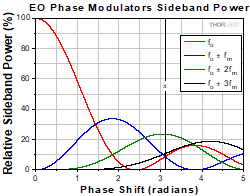
Click to Enlarge
Figure G2.2 EO位相変調器の相対的な側波帯強度
当社のEO位相変調器は、直線偏光した入射光に電気的に制御された位相シフトを与えます。制御信号はDC信号の場合や時間によって変化する信号の場合があります。制御電圧が時間によって変化する場合、光の周波数が変調されます。このとき、基本周波数のエネルギの一部は変調周波数の整数倍だけ基本周波数から分離された側波帯に変換されます。変調の深さによって側波帯に変換されるエネルギの量が決まります。Figure G2.2は、変調深さの関数としての相対的な側波帯の強度を示しています。

当社の共振型電気光学(EO)変調器は、内部にある高Q値のタンク回路によって、小さなRF入力電圧を最大変調深度が得られる高電圧まで昇圧させることができます。これにより、一般的なファンクションジェネレータでの駆動が可能です。標準品の20 MHz共振型振幅変調器のQ値は14、半波電圧はわずか15 Vです。性質上、位相変調器の半波電圧は振幅変調器の約3分の2であるため、20 MHz共振型位相変調器のVpiはおよび10 Vとなります。
当社では、標準品の共振型変調器として、20 MHzにて1 MHzの帯域幅で動作する、位相変調型と振幅(強度)変調型の両方をご用意しております。いずれにも600~900 nmの波長に対応した-C1コーティングが施されています。特注で、標準的なC1~C4のARコーティングの指定と0.1~100 MHzの共振周波数の指定が可能です。なお、Q値は共振周波数の関数のため、20 MHzモデルとは大幅に異なる場合があります。用途に応じた製品に関しては、当社 までご相談ください。

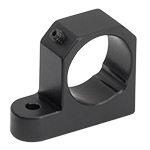
Click to Enlarge
Figure G4.1 偏光子取付けアダプタEO-PMT
- GTH5M取付け用アダプタ、当社のEO変調器用
- 回転することにより光路への出入りが可能
- GTH5M用Ø13 mm開口
- #2-56取付けネジとワッシャが付属
EO-PMTによって、グラントムソン偏光子(GTH5M)を当社の電気光学(EO)変調器へ簡単に取り付けることができます。このマウントでは取付け部が1つなので、偏光子を旋回させて光路へ出入りさせることができ、EO変調器のアライメントや調節に便利です。EO-GTH5Mには、グラントムソン偏光子(GTH5M)と取付けアダプタがセットになっています。

Figure G5.1 当社のEO変調器は、5軸ステージPY005(/M)、ブラケットFT-EOMAならびにベースPY005A1(/M)を用いて50.8 mmのビーム高とするか(a)、直接ステージPY005(/M)に取り付ける(b)ことが可能です。
- 5軸調整機能付き小型プラットフォーム
- アダプターブラケット:EO変調器をプラットフォームまたは長さ70 mm超のFiberBenchに取り付け
- 取付ベースPY005A1/MにEO変調器を取り付け、PY005/MとFT-EOMAもあわせて使用すると、ビーム高は50.8 mm(公称値)
- 全ての取付アダプタには取付用ネジが付属
PY005/Mは5自由度の小型プラットフォームです。5つのアクチュエータのうち、2つがヨーとY軸、2つがピッチとZ軸、1つがX軸を調整します。ヨーとY軸のアクチュエータに接着剤で取り付けられている2つのロック用カラーF19SC1は、これらのアクチュエータがオーバードライブをしないようハードストップとして機能します。ピッチ、X軸、Z軸のアクチュエータは底部に内孔があることによりオーバードライブを防いでいます。 なお、ステージの総移動量が小さくなるため、ロック用カラーF19SC1をピッチ、X軸、Z軸のアクチュエータに使用することはお勧めしていません。こちらをクリックするとPY005/Mステージの詳細がご覧になれます。
EO変調器は、ステージ底面にあるザグリ穴を使用して直接PY005/Mに取り付けることも可能です(Figure G5.1 (b)参照)。ザグリ穴には、ベースPY005A1/Mがステージの下に取り付けられている状態でもアクセスできます。またEO変調器はアダプターブラケットFT-EOMAを使用してステージに取り付けることも可能です(Figure G5.1 (a)参照)。FT-EOMAを使用してEO変調器をステージに取り付け、ベースPY005A1/Mをステージの下に取り付けた場合、EO変調器の光軸高さは光学テーブルから50.8 mm(公称値)になります。
アダプターブラケットFT-EOMAを使用してEO変調器をFiberBenchに取り付けることも可能です。EO変調器を取り付けるベンチの長さは最低70 mm必要です。偏光子付きマウントアダプタ(EO-GTH5M)を組み込む場合にはさらに長いFiberBenchが必要となります。FiberBenchシステムのEO変調器には直線偏光モジュールの使用が適しています。Figure G5.2は、EO変調器に多軸のFiberBenchFT-38X100と直線偏光モジュールを各1つと、2つのFiberPortを組み合わせた使用例です。
 Products Home
Products Home











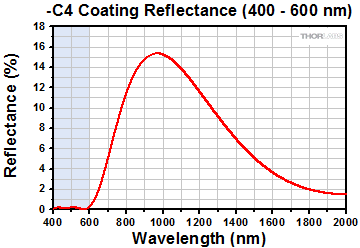
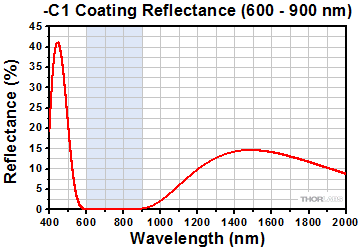
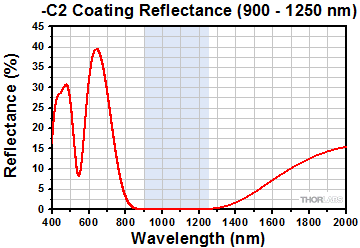
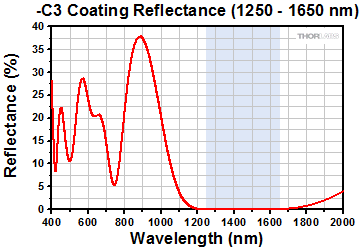
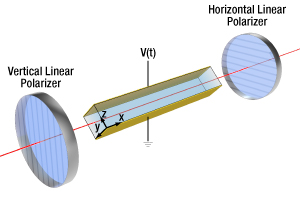
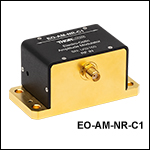
 ズーム
ズーム

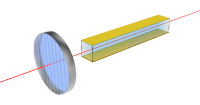

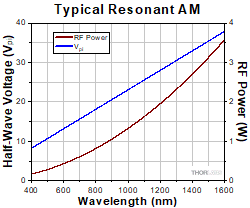
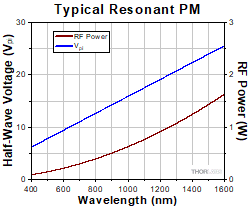
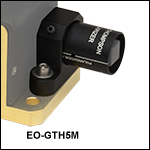
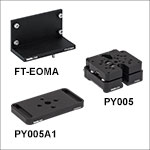
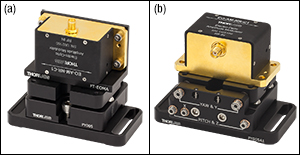
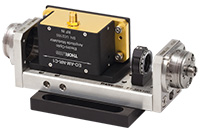
 自由空間型EO変調器
自由空間型EO変調器